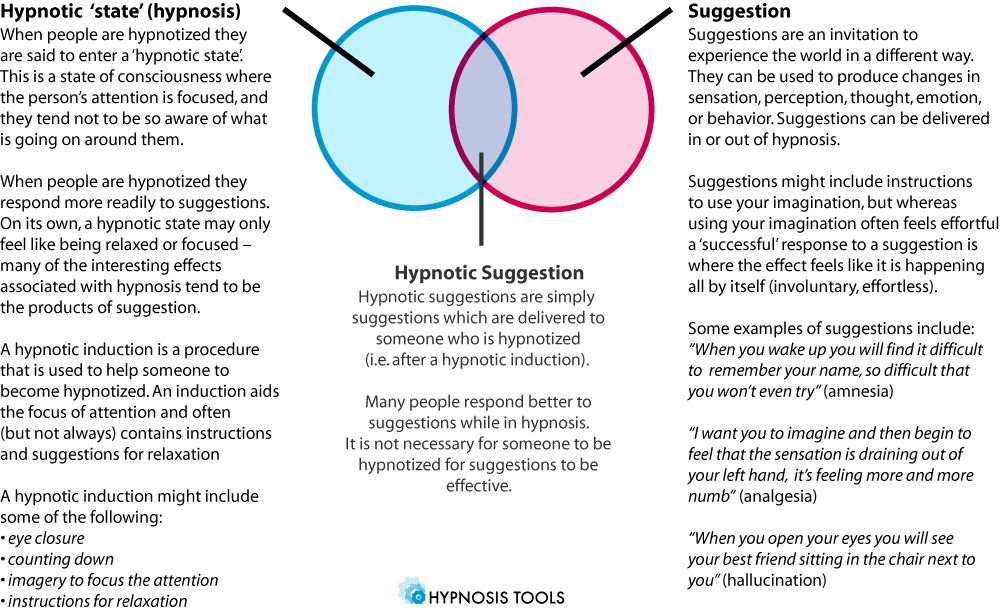Definitions of hypnosis and suggestion
Hypnosis has often been carved into two separate elements - the hypnotic state (thought by some to be an 'altered state of consciousness', and sometimes called a 'trance' state) and suggestion (e.g. see Heap 1996). This distinction has led to some useful research, and is particularly important when considering the results of neuroimaging research. However, it is important to note that not all researchers agree with this definition (see Barnier 2008).

Figure: Separation of the hypnotic state and suggestion can be a useful way of thinking about the effects of hypnosis
Hypnotic State / 'Trance' / Induction
A hypnotic 'trance' can be brought about by giving a willing participant instructions to focus on the hypnotist's voice, to concentrate their attention, and to pay attention to their inner mental world (this is called a hypnotic induction). Some hypnotic inductions include suggestions for relaxation, but this is not strictly necessary. Researchers debate whether a hypnotic trance is an altered state of consciousness, that is, whether an individual's consciousness is altered by becoming hypnotised (see the state/non-state section for more information on this). We might say someone is in hypnosis if they have:
- Focused attention
- Are not attending to extraneous stimuli
- Are absorbed in some activity, image, thought or feeling
Many hypnotists liken the hypnotic 'state' to everyday experiences which people enter spontaneously, such as:
- Being 'lost in thought' or day dreaming
- Absorption in sport, reading, listening to music etc
- Driving for long distances and not recalling the route taken
- Being absorbed in meditation / relaxation procedures.
A hypnotic induction is where participants are given a series of instructions which, if they follow them, are intended to assist them in achieving a hypnotised state. Hypnotic procedures are intended to encourage focused attention, disattention to surroundings, and absorption in innter mental world. With practice, some people are able to enter the desired state very quickly: either spontaneously or by thinking through a hypnotic procedure. Hypnotic procedures are generally facilitated by:
- Encouraging the participant to be non-analytical in their thinking
- Increasing the participant's motivation and willingness to actively involve themselves with the procedures
- Raising participant's expectancies of a positive outcome
Suggestion
Suggestions can be given for alterations in the contents of consciousness, and can target perception, sensation, cognition, emotion, or behaviour. It is widely acknowledged that many of the interesting effects associated with hypnosis are actually brought about by suggestion (e.g. see Kihlstrom, 2008). Suggestions differ from everyday kinds of instructions in that a 'successful' response is experienced by the subject as having a quality of involuntariness, effortlessness, or 'realness': suggested behaviours often feel involuntary, and other changes feel effortless and 'real'. One widely held belief is that being in a 'hypnotic state' facilitates responsiveness to suggestion, and there is some evidence to support this. However, people can also respond to suggestions without being taken through a hypnotic procedure first - in the absence of hypnosis people are said to be responding to imaginative suggestions.
Suggestions are often accompanied by appropriate imagery but the following effects can be produced by direct suggestion without imagery:
- Relaxation (e.g. "You are becoming more and more relaxed as time goes by")
- Arm levitation (e.g. "You might begin to notice your arm becoming lighter, and beginning to float up in the air")
- Analgesia (e.g. "Notice the feeling in your hand becoming less and less, your hand becoming numb")
- Amnesia (e.g. "When you wake up, you won't remember anything that happened during this session")
- Post-hypnotic suggestion (e.g. "Later, when I click my fingers, you will scratch your nose")
My definition of hypnosis and suggestion
In motivated participants, hypnosis and response to suggestion is the relinquishing of some aspects of normal functioning by the executive control system. This allows for an an action to be initiated, but for the system to 'forget' that it initiated the action - in which case the action is experienced as involuntary. Or, it allows a scenario to be imagined, but for the executive control system to become unaware that it initiated the imagination, and for the resulting scenario to be experienced 'as real'.
What is hypnosis?
Definitions of hypnosis
Types of suggestion
FAQ
Scientific theories of hypnosis
History of hypnosis
Animal hypnosis
Key people in hypnosis
Demand characteristics
Scientific research
States of consciousness
Neuroscience
Modification of suggestibility
Attention and hypnosis
Pain research
Hypnosis as a research tool
Genes and hypnotizability
What is hypnotherapy?
Is it effective?
Finding a therapist
Depression
Irritable bowel syndrome
Pain
PTSD
Smoking
Surgery
Weight loss
Hypnosis research papers
Suggestibility scales
Scripts
Videos
Forum
Organisations
Journals
Book reviews
© 2007-2019 Dr Matthew Whalley
